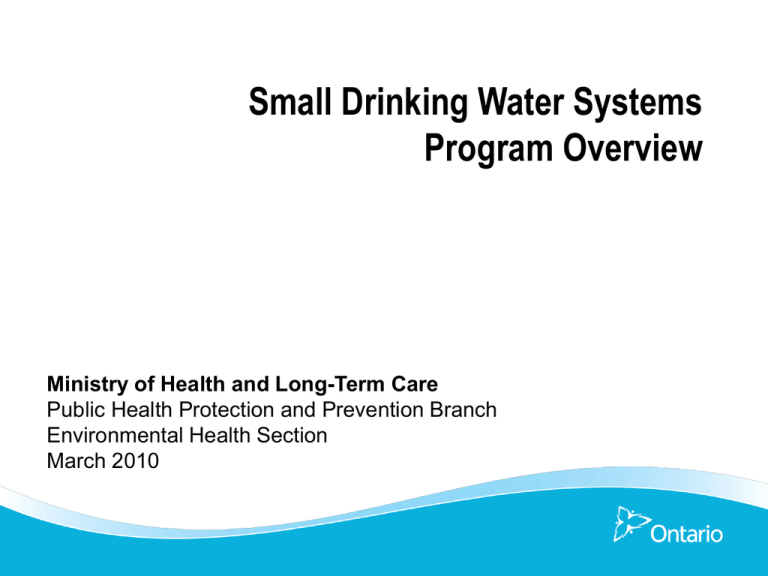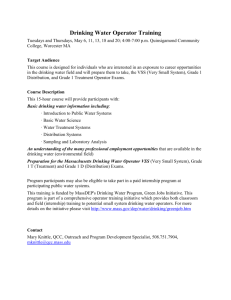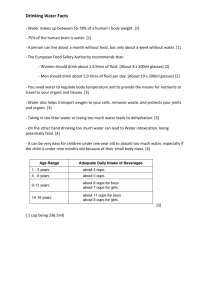Day 1 - MHLTC Initiatives - Regional Panel
advertisement

Small Drinking Water Systems Program Overview Ministry of Health and Long-Term Care Public Health Protection and Prevention Branch Environmental Health Section March 2010 Outline • Context of transfer of small drinking water systems • Overview of the program • Ongoing ministry support of public health units 1 Report of the Walkerton Inquiry, 2002 “While it is not possible to utterly remove all risk from a water system, the recommendations’ overall goal is to ensure that Ontario’s drinking water systems deliver water with a level of risk so negligible that a reasonable and informed person would feel safe drinking the water” 2 The Public Health Approach • Under the new risk-based approach, public health inspectors will conduct a site-specific risk assessment on every small drinking water system in the province • Based on the assessment, they will determine what owners and operators must do to keep their drinking water safe….. • This reflects a customized approach for each small drinking water system depending on the level of risk, rather than “onesize-fits-all “ requirements 3 SDWS Program Response to AWQI • Lab responsible for contacting operator, PHU and MOHLTC • PHI responds to AWQI • LRMA will collect AWQI information Directive Issued AWQI • Identify the system • Ensure it is under O.Reg.318/08 • Gather information about the system • Issue a SDWS ID# Identification • Operator submits regulatory samples to lab • Operator required to submit at a frequency based on directive • Sample results uploaded to LRMA by private lab Site Specific Risk Assessment Sampling Requirement • Required for each system • Results in a risk category and issuing a directive • Directives will include site specific requirements Ongoing Monitoring • PHI to monitor sampling requirements through LRMA • PHI follow up with non-compliant owner/operators Compliance Monitoring Other Inspections Outreach and Building Inventory 4 • May be completed as a result of an AWQI, compliance issue, complaint or other reason • May result in a corrective action, directive or in providing information to the operator. Types of drinking water systems included in the transfer? • Non-municipal seasonal residential system that • serve 6 or more private residences, or • have 6 or more service connections, and • operates with at least one annual 60 consecutive day gap within a calendar year • Examples include seasonal trailer parks, campgrounds, recreational camps 5 Types of drinking water systems included in the transfer? • Municipally owned sports facilities, parks, arenas, recreation centres • Privately owned resorts, marinas, churches, mosques • Food service premises • Places that operate primarily for the purpose of providing overnight accommodations to the traveling public such as motels, hotels, etc. • Where a service club or fraternal organization meets on a regular basis 6 General Requirements of Small Drinking Water Systems Reg’s Notification of intention to supply water Designating an operator Sampling and testing Treatment Response to adverse test results and observations Directives Request for review • • • • • • • 7 Site Specific Risk Assessments • Observations of the system components, equipment, distribution system, the site and the surrounding property • Reviewing documentation pertaining to the system such as owner’s manuals for equipment and well records. • Interviewing the owner / operator to determine experience and competencies in operating the small drinking water system • Reviewing historical water sample test results if available 8 Assessment using the Risk Categorization tool RCat applies a general questionnaire to determine the risk category of a small drinking water system: • • • • • • 9 Part 1 – General Information Part 2 – Source Part 3 – Treatment Part 4 – Distribution Part 5 – Flow Diagram Part 6 – Grading System (Risk Category Main points and grading chart) RCat and Risk Categorization Grade for Source and Treatment Criteria Risk Category for Small Drinking Water System . •High = Significant level of risk •Medium = Moderate level of risk •Low = Negligible level of risk A Grade for Distribution Criteria a b c d 10 B √ C D Directive issued after completion of a site specific assessment • The directive is legally binding on the owner of the small drinking water system as well as any subsequent owner • Provides requirements for the safe operation of the drinking water system (sampling, treatment, operator training, etc) • The directive is in force for as long as the small drinking water system is in operation 11 Monitoring Compliance • Reviewing water sampling test results submitted to commercial laboratories • Lab results are uploaded into the Laboratory Results Management Application (LRMA) where they are monitored by the PHI • Response to adverse water quality incidents, complaints, inquiries • Integration with other responsibilities of the PHI 12 Ministry Support • Develop and maintain the regulations, standards, protocols and guidance documents for the consistent delivery of the program • Resource manual complete with all business processes, regulations, fact sheets, short-form wording, etc. • Fact sheets for owner/operators available on ministry website 13 Ministry Support IT systems support • The Risk categorization tool (RCat) • Laboratory Results Management Application (LRMA) Provide ongoing program and technical training 14 Ministry Support • Technical consulting firm available to PHI’s by phone, e-mail, portal. • Monthly teleconferences with PHI’s • Self learning modules and SME’s in the field proposed 15 Drinking Water Ontario 16 Contact / Questions Tony Amalfa, B.Sc., C.P.H.I.(C) Manager, Environmental Health Public Health Protection and Prevention Branch Ministry of Health and Long-Term Care Public Health Division 5700 Yonge Street, 2nd Floor Toronto, Ontario M2M 4K5 Tel: (416) 327-7624 Email: Tony.Amalfa@ontario.ca 17





